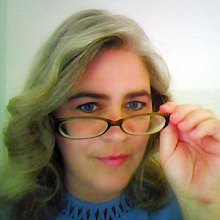 A novel of fiction should immerse a reader into a world full of amazing characters overcoming obstacles, growing as humans and perhaps being victorious, but that world must be painted for the reader. Scenes should be vivid. Whether you are writing science fiction, fantasy or a Young Adult novel, good imagery is a must. Imagery is the formation of mental images. This can be achieved using similes, metaphors, and personification.
A novel of fiction should immerse a reader into a world full of amazing characters overcoming obstacles, growing as humans and perhaps being victorious, but that world must be painted for the reader. Scenes should be vivid. Whether you are writing science fiction, fantasy or a Young Adult novel, good imagery is a must. Imagery is the formation of mental images. This can be achieved using similes, metaphors, and personification.A simile is a figure of speech where two unlike things are compared using “like” or “as”.
Example: The principal stood proud at the top of the steps like the Statue of Liberty, welcoming the students on the first day of the new school year.
A metaphor makes a comparison without using “like” or “as”.
Example: Her eyes were shinning beacons of bright light, expressing her hope for their futures.
Personification takes a non-human item and gives it the attributes of a human.
Example: The open doors welcomed the students as the first bell warned them that they had five more minutes to make it to their homerooms.
Imagery combined with good use of the five senses can make the world your characters are in come alive for the reader, but be careful not to overdue your descriptions. Remember that your readers are intelligent people. They are able to form a full mental picture from just a few well-planned sentences. As you read the example below, think of the mental images you get.
*
Martin quickened his steps through the tall trees, his booted feet crunching over fallen leaves and twigs as he got closer to the sound of rushing water. The freezing mist fell on him like confetti on New Year’s Eve almost as if to congratulate him for clearing the trees and coming upon the swollen river. His elation turned to frustration as the foaming water laughed, taunting him with its depth and width.
He sat on a moss-covered boulder and gazed up into the rapidly dimming sky. At least now, the helicopter might spot him. That is if they hadn’t given up for the day. Martin folded his arms to try to stay warm and glanced around, willing his mind to stay sharp. Spotting some fallen branches at the base of a large tree, he jumped off the boulder and dragged the slimy limbs closer to the rock where it blocked the wind. The branches were probably too damp to light on fire, but hope bubbled up from within him and with trembling hands, he flicked the lighter on and prayed for a miracle.
*
What kind of trees did you see? Pine trees, redwoods, or another type? How steep was the river’s bank? Did Martin see gray clouds in the sky as he looked up? All of these details where probably formed into your mind’s eye and I did not have to spell it out for you. Someone might see different trees than you did, but unless the types of trees are integral to the story, it is not an important detail. Naturally, there would be some clouds in the sky because there was a mist falling. I did not have to describe the clouds.
Imagery is a great tool to use to show the reader what the environment is like without having to tell them. Notice the absence of the words “were” and “was” in my example. I was able to paint a picture of the forest without having to tell my readers what they should be seeing. I just let them experience it along with my character.
I had a hard time understanding the idea of imagery until I read an article by Stephen King in a writer’s guide that I had picked up at a thrift store. In fact, the short story that I recently posted to this blog started out as an exercise in imagery after reading his article. I have done searches on the internet and so far, I have not found articles or websites that stand out as excellent when dealing with this subject. If you know of some good sites or have some wisdom to add about imagery, please comment to this post.
If you haven't already, please check out my new website: www.writerpatty.com













 In September of 1982, my parents gave me a diary for my tenth birthday. I started writing in it nightly. To this day, I can’t make out some of the words, but it was filled with the goings on of my young life. Every year after, while I was in school, someone gave me a diary for my birthday. Looking at my last diary from when I was seventeen, I am ashamed to say that I still can’t read some of the words. Of the ones I can read, many of them are spelled wrong and it takes a bit of thinking to figure out what I was trying to write about.
In September of 1982, my parents gave me a diary for my tenth birthday. I started writing in it nightly. To this day, I can’t make out some of the words, but it was filled with the goings on of my young life. Every year after, while I was in school, someone gave me a diary for my birthday. Looking at my last diary from when I was seventeen, I am ashamed to say that I still can’t read some of the words. Of the ones I can read, many of them are spelled wrong and it takes a bit of thinking to figure out what I was trying to write about.





